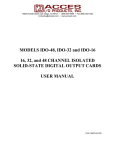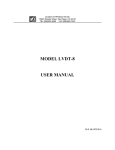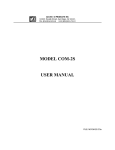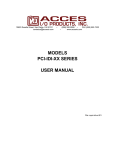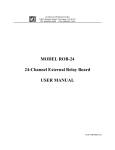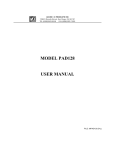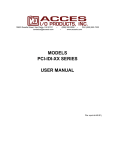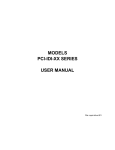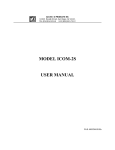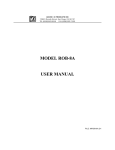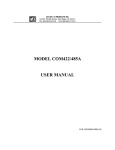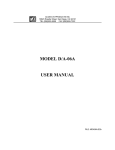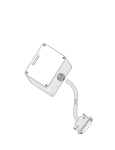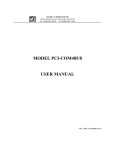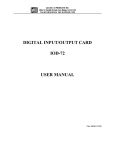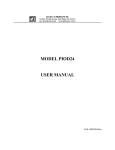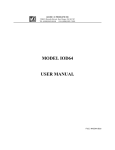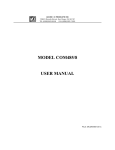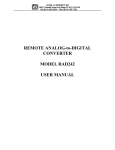Download IDI_XX Manual - ACCES I/O Products
Transcript
ACCES I/O PRODUCTS INC 10623 Roselle Street, San Diego, CA 92121 TEL (858)550-9559 FAX (858)550-7322 MODEL IDI-xx USER MANUAL FILE: MIDI-xx.A6c Notice The information in this document is provided for reference only. ACCES does not assume any liability arising out of the application or use of the information or products described herein. This document may contain or reference information and products protected by copyrights or patents and does not convey any license under the patent rights of ACCES, nor the rights of others. IBM PC, PC/XT, and PC/AT are registered trademarks of the International Business Machines Corporation. Printed in USA. Copyright 1995 by ACCES I/O Products Inc, 10623 Roselle Street, San Diego, CA 92121. All rights reserved. Pageiii Warranty Prior to shipment, ACCES equipment is thoroughly inspected and tested to applicable specifications. However, should equipment failure occur, ACCES assures its customers that prompt service and support will be available. All equipment originally manufactured by ACCES which is found to be defective will be repaired or replaced subject to the following considerations. Terms and Conditions If a unit is suspected of failure, contact ACCES' Customer Service department. Be prepared to give the unit model number, serial number, and a description of the failure symptom(s). We may suggest some simple tests to confirm the failure. We will assign a Return Material Authorization (RMA) number which must appear on the outer label of the return package. All units/components should be properly packed for handling and returned with freight prepaid to the ACCES designated Service Center, and will be returned to the customer's/user's site freight prepaid and invoiced. Coverage First Three Years: Returned unit/part will be repaired and/or replaced at ACCES option with no charge for labor or parts not excluded by warranty. Warranty commences with equipment shipment. Following Years: Throughout your equipment's lifetime, ACCES stands ready to provide on-site or in-plant service at reasonable rates similar to those of other manufacturers in the industry. Equipment Not Manufactured by ACCES Equipment provided but not manufactured by ACCES is warranted and will be repaired according to the terms and conditions of the respective equipment manufacturer's warranty. General Under this Warranty, liability of ACCES is limited to replacing, repairing or issuing credit (at ACCES discretion) for any products which are proved to be defective during the warranty period. In no case is ACCES liable for consequential or special damage arriving from use or misuse of our product. The customer is responsible for all charges caused by modifications or additions to ACCES equipment not approved in writing by ACCES or, if in ACCES opinion the equipment has been subjected to abnormal use. "Abnormal use" for purposes of this warranty is defined as any use to which the equipment is exposed other than that use specified or intended as evidenced by purchase or sales representation. Other than the above, no other warranty, expressed or implied, shall apply to any and all such equipment furnished or sold by ACCES. Page iv Table of Contents Notice . . . . . . . . . . . . . . . . . . . . . . . . . . . . . . . . . . . . . . . . . . . . . . . . . . . . . . . . . . . . . . iii Warranty . . . . . . . . . . . . . . . . . . . . . . . . . . . . . . . . . . . . . . . . . . . . . . . . . . . . . . . . . . . ii Chapter 1: Introduction . . . . . . . . . . . . . . . . . . . . . . . . . . . . . . . . . . . . . . . . . . . . . . 1-1 Description . . . . . . . . . . . . . . . . . . . . . . . . . . . . . . . . . . . . . . . . . . . . . . . . . . . . . . . . . . . 1-1 Specification . . . . . . . . . . . . . . . . . . . . . . . . . . . . . . . . . . . . . . . . . . . . . . . . . . . . . . . . . . 1-3 Chapter 2: Installation . . . . . . . . . . . . . . . . . . . . . . . . . . . . . . . . . . . . . . . . . . . . . . 2-1 CD Installation . . . . . . . . . . . . . . . . . . . . . . . . . . . . . . . . . . . . . . . . . . . . . . . . . . . . . . . . . 3.5-Inch Diskette Installation . . . . . . . . . . . . . . . . . . . . . . . . . . . . . . . . . . . . . . . . . . . . . . Directories Created on the Hard Disk . . . . . . . . . . . . . . . . . . . . . . . . . . . . . . . . . . . . . . . Installing the Card . . . . . . . . . . . . . . . . . . . . . . . . . . . . . . . . . . . . . . . . . . . . . . . . . . . . . . 2-1 2-1 2-2 2-4 Chapter 3: Option Selection . . . . . . . . . . . . . . . . . . . . . . . . . . . . . . . . . . . . . . . . . . 3-1 Chapter 4: Address Selection . . . . . . . . . . . . . . . . . . . . . . . . . . . . . . . . . . . . . . . . . 4-1 Chapter 5: Software . . . . . . . . . . . . . . . . . . . . . . . . . . . . . . . . . . . . . . . . . . . . . . . . . 5-1 Chapter 6: Programming . . . . . . . . . . . . . . . . . . . . . . . . . . . . . . . . . . . . . . . . . . . . . 6-1 Chapter 7: Connector Pin Assignments . . . . . . . . . . . . . . . . . . . . . . . . . . . . . . . . 7-1 Page v List of Figures Figure 1-1: IDI-48 Block Diagram . . . . . . . . . . . . . . . . . . . . . . . . . . . . . . . . . . . . . . . . . . . . 1-4 Figure 3-1: IDI-48 Option Selection Map . . . . . . . . . . . . . . . . . . . . . . . . . . . . . . . . . . . . . . . 3-2 List of Tables Table 4-1: Standard Address Assignments for 286/386/486 Computers . . . . . . . . . . . . . . . 4-1 Table 6-1: Address Selection Table . . . . . . . . . . . . . . . . . . . . . . . . . . . . . . . . . . . . . . . . . . . 6-1 Table 7-1: Connector Pin Assignments . . . . . . . . . . . . . . . . . . . . . . . . . . . . . . . . . . . . . . . . 7-1 Page vi Chapter 1: Introduction Features • • • • • Individually-Isolated Digital Inputs for up to Three 16-Bit Groups. Polarity-Protected Input Voltage Amplitudes to 24V and 60V. 500Vrms Isolation, Channel-to-Channel and Channel-to-Host PC. On-Board Shields Prevent Accidental Contact with User Voltages. Some Models Can Generate Interrupts When Input Bits Change State. Description IDI-xx Series cards provide individual-input optical isolation and accept as many as 48 parallel differential digital inputs at voltages up to 60 VDC. Protection circuits are included in case of accidental polarity reversal of input connections. These cards provide a much lower cost per point than externally-mounted, optically-isolated, solid-state modules or PLCs. Input connections are via ribbon-cable headers on the card and a tie-down bar is included to provide strain relief for those cables. IDI- Series cards are especially useful in applications where high-common-mode external voltages are present as found in factory automation, energy management, security systems, and process monitoring applications. In addition to protecting your computer from accidental contact with high external voltages, the isolation provided eliminates troublesome ground loops. There are 48-bit, 32-bit, and 16-bit versions. The latter two models are de-populated versions of the 48-bit card. Further, letters are appended to the model numbers to signify options included on the card. Models available are as listed in the table on the next page. Manual MIDI-xx.A6c Page 1-1 IDI-xx Manual Model No. of Bits Max. Input Voltage Change-of-State Interrupt Capability IDI-16A 16 28V No IDI-16AC 16 28V Yes IDI-16B 16 60V No IDI-16BC 16 60V Yes IDI-32A 32 28V No IDI-32AC 32 28V Yes IDI-32B 32 60V No IDI-32BC 32 60V Yes IDI-48A 48 28V No IDI-48AC 48 28V Yes IDI-48B 48 60V No IDI-48BC 48 60V Yes The change-of-state interrupt capability included in "AC" and "BC" models provides means to automatically interrupt the host computer in real time. When one or more input bits change state, latched interrupt requests are generated. That interrupt, in turn, can be used by your application program to initiate a poll of the inputs, then signal appropriate alarms, and/or initiate scan of other I/O points that have not been previously activated. This can greatly simplify your application program and eliminate need to continuously poll inputs. Interrupts IRQ2 through 7 (or IRQ 10-12 and 14-15 in AT-class computers) can be selected by jumper installation on the card. Change-of-state interrupt is enabled/disabled independently for each group of 16 bits. Mode switches 0 (for Port 0 bits), 1 (for Port 1 bits), and 2 (for Port 2 bits) are located near the mounting bracket. Page 1-2 Manual MIDI-xx.A6c Specification Features • • • • • Individually-isolated Digital Inputs for up to Three 16-Bit Groups. Polarity-Protected Input Voltage Amplitudes to 24V and 60 V. 500 Vrms Isolation, Channel-to-Channel and Channel-to-Host PC. Some Models Have On-Board Microcontroller and Can Generate Interrupts When Bits Change State. On-Board Shield Prevents Accidental Contact with User Voltages. Digital Inputs • • Logic 0: Logic 1: Open or 1.5V maximum. 28V Models: 3.5V min. at 0.6 mA. 28V max. at 13 mA. 60V Models: 2.4V min. at 2.0 mA. 60V max. at 2.3 mA. • Frequency Response: • Isolation: • • Power Required : Size: 28V Models: Up to 5 KHz 60V Models: Up to 10 KHz 500 Vrms channel-to-channel and channel-to-computer. (Note: Alternate wires in the ribbon cables are not connected at the card, thus providing bit- to-bit isolation higher than that normally provided by ribbon cables.) +5VDC at 300mA maximum. 13.310" long. Environmental • • • Operating Temperature Range: 0 °C. to 60 °C. Storage Temperature Range: -20 °C. to +100 °C. Humidity: 0% to 90% RH without condensation. Manual MIDI-xx.A6c Page 1-3 IDI-xx Manual Figure 1-1: IDI-48 Block Diagram Page 1-4 Manual MIDI-xx.A6c Chapter 2: Installation The software provided with this card is contained on either one CD or multiple diskettes and must be installed onto your hard disk prior to use. To do this, perform the following steps as appropriate for your software format and operating system. Substitute the appropriate drive letter for your CD-ROM or disk drive where you see d: or a: respectively in the examples below. CD Installation DOS/WIN3.x 1. 2. 3. 4. Place the CD into your CD-ROM drive. Type d:K to change the active drive to the CD-ROM drive. Type installK to run the install program. Follow the on-screen prompts to install the software for this card. WIN95/98/NT a. b. c. Place the CD into your CD-ROM drive. The CD should automatically run the install program after 30 seconds. If the install program does not run, click START | RUN and type d:install, click OK or press K. Follow the on-screen prompts to install the software for this card. 3.5-Inch Diskette Installation As with any software package, you should make backup copies for everyday use and store your original master diskettes in a safe location. The easiest way to make a backup copy is to use the DOS DISKCOPY utility. In a single-drive system, the command is: diskcopy a: a:K You will need to swap disks as requested by the system. In a two-disk system, the command is: diskcopy a: b:K This will copy the contents of the master disk in drive A to the backup disk in drive B. Manual MIDI-xx.A6c Page 2-1 IDI-xx Manual To copy the files on the master diskette to your hard disk, perform the following steps. a. Place the master diskette into a floppy drive. b. Change the active drive to the drive that has the diskette installed. For example, if the diskette is in drive A, type a:K. c. Type installK and follow the on-screen prompts. Directories Created on the Hard Disk The installation process will create several directories on your hard disk. If you accept the installation defaults, the following structure will exist. [CARDNAME] Root or base directory containing the SETUP.EXE setup program used to help you configure jumpers and calibrate the card. DOS\PSAMPLES: DOS\CSAMPLES: Win32\language: A subdirectory of [CARDNAME] that contains Pascal samples. A subdirectory of [CARDNAME] that contains "C" samples. Subdirectories containing samples for Win95/98 and NT. WinRisc.exe A Windows dumb-terminal type communication program designed for RS422/485 operation. Used primarily with Remote Data Acquisition Pods and our RS422/485 serial communication product line. Can be used to say hello to an installed modem. ACCES32 This directory contains the Windows 95/98/NT driver used to provide access to the hardware registers when writing 32-bit Windows software. Several samples are provided in a variety of languages to demonstrate how to use this driver. The DLL provides four functions (InPortB, OutPortB, InPort, and OutPort) to access the hardware. This directory also contains the device driver for Windows NT, ACCESNT.SYS. This device driver provides register-level hardware access in Windows NT. Two methods of using the driver are available, through ACCES32.DLL (recommended) and through the DeviceIOControl handles provided by ACCESNT.SYS (slightly faster). Page 2-2 Manual MIDI-xx.A6c SAMPLES Samples for using ACCES32.DLL are provided in this directory. Using this DLL not only makes the hardware programming easier (MUCH easier), but also one source file can be used for both Windows 95/98 and WindowsNT. One executable can run under both operating systems and still have full access to the hardware registers. The DLL is used exactly like any other DLL, so it is compatible with any language capable of using 32-bit DLLs. Consult the manuals provided with your language's compiler for information on using DLLs in your specific environment. VBACCES This directory contains sixteen-bit DLL drivers for use with VisualBASIC 3.0 and Windows 3.1 only. These drivers provide four functions, similar to the ACCES32.DLL. However, this DLL is only compatible with 16-bit executables. Migration from 16-bit to 32-bit is simplified because of the similarity between VBACCES and ACCES32. PCI This directory contains PCI-bus specific programs and information. If you are not using a PCI card, this directory will not be installed. SOURCE A utility program is provided with source code you can use to determine allocated resources at run-time from your own programs in DOS. PCIFind.exe A utility for DOS and Windows to determine what base addresses and IRQs are allocated to installed PCI cards. This program runs two versions, depending on the operating system. Windows 95/98/NT displays a GUI interface, and modifies the registry. When run from DOS or Windows3.x, a text interface is used. For information about the format of the registry key, consult the card-specific samples provided with the hardware. In Windows NT, NTioPCI.SYS runs each time the computer is booted, thereby refreshing the registry as PCI hardware is added or removed. In Windows 95/98/NT PCIFind.EXE places itself in the boot-sequence of the OS to refresh the registry on each power-up. This program also provides some COM configuration when used with PCI COM ports. Specifically, it will configure compatible COM cards for IRQ sharing and multiple port issues. WIN32IRQ This directory provides a generic interface for IRQ handling in Windows 95/98/NT. Source code is provided for the driver, greatly simplifying the creation of custom drivers for specific needs. Samples are provided to demonstrate the use of the generic driver. Note that the use of IRQs in near-real-time data acquisition programs requires multi-threaded application programming techniques and must be considered an intermediate to advanced programming topic. Delphi, C++ Builder, and Visual C++ samples are provided. Manual MIDI-xx.A6c Page 2-3 IDI-xx Manual Findbase.exe DOS utility to determine an available base address for ISA bus , non-Plug-n-Play cards. Run this program once, before the hardware is installed in the computer, to determine an available address to give the card. Once the address has been determined, run the setup program provided with the hardware to see instructions on setting the address switch and various option selections. Poly.exe A generic utility to convert a table of data into an nth order polynomial. Useful for calculating linearization polynomial coefficients for thermocouples and other non-linear sensors. Risc.bat A batch file demonstrating the command line parameters of RISCTerm.exe. RISCTerm.exe A dumb-terminal type communication program designed for RS422/485 operation. Used primarily with Remote Data Acquisition Pods and our RS422/485 serial communication product line. Can be used to say hello to an installed modem. RISCTerm stands for Really Incredibly Simple Communications TERMinal. Installing the Card Before installing the card, carefully read the Address Selection and Option Selection chapters of this manual and configure the card according to your requirements. Use the special software program called SETUP provided on CD with the card. It supplies visual aids to configure all areas of the board. Be especially careful with address selection. If the addresses of two installed functions overlap, you will experience unpredictable computer behavior. If unsure what locations are available, you can use the FINDBASE program provided on CD to locate blocks of available addresses. Page 2-4 Manual MIDI-xx.A6c To Install the Card 1. 2. 3. 4. 5. 6. 7. 8. 9. 10. 11. Remove power from the computer. Remove the computer cover. Remove blank I/O backplate. Install jumpers for selected options. See Option Selection Select the base address on the card. See Address Selection Loosen the nuts on the strain relief bar and swing top end free. Install the card in an I/O expansion slot. If convenient, select a slot adjacent to a vacant slot because this will make cable installation easier. If a safety jacket is to be used, install that jacket on the cables. (See note below.) Then thread the cable bundle through the cutout in the mounting bracket and plug individual cables into the headers. Smooth the cables as close as possible to the card and, while holding them close to the surface of the card, swing the strain relief bar into position and tighten nuts. Inspect for proper fit of the card and cables and tighten screws. Replace the computer cover. Warning This card can be used with signals that contain very high common mode voltages. For safety the cables should not be connected to the sources of those signals when installing or removing connections to IDI-xx. Further, to assure that the cables aren't pinched by the strain relief bar it is good safety practice to enclose the cables in a protective jacket. PVC protective jacketing is available that meets UL, CSA, and MIL specifications. Note If your application will involve high voltages and high common mode voltages, then you may want to consider using a protective jacket on the ribbon cables. Optional "Zipper-tubing" shielded protective jackets are available. The jacket uses 10-mil, high-temperature PVC material laminated to a 1-mil shield of aluminum foil/polyester and groundable through a tinned copper braid. Input/Output connections are via 50-pin header(s) on the card. A blank mounting bracket is provided with units that are marked for CE (European) Certification and, for these units, CE-certifiable cabling and break-out methodology (cables connected to ground at the aperture, shielded twisted pair wiring, etc.) must be used. Also, it is important that the card mounting bracket be properly screwed into place and that there be a positive chassis ground. Manual MIDI-xx.A6c Page 2-5 IDI-xx Manual Page 2-6 Manual MIDI-xx.A6c Chapter 3: Option Selection Refer to the setup programs provided with the card. Also, refer to the Block Diagram and the Option Selection Map when reading this section of the manual. IRQ Selection Interrupt levels IRQ2-7, 10-12, and 14-15 are available. Select the level that you want to use by installing a jumper in one of those locations. Mode Switch (Note: This switch is only available in "C" versions) Positions 0, 1, and 2 are the only positions used in the standard versions of 16-, 32-, and 48-bit versions respectively. When these switches are ON, change-of-state interrupt operation is enabled for the associated Port 0, Port 1, and Port 2 groups of bits. The remaining two switches may be used in special versions of these IDI- Series cards. If you have a special version, there is an Addendum sheet in the front of this manual describing the special modification that is included. Manual MIDI-xx.A6c Page 3-1 IDI-xx Manual Figure 3-1: IDI-48 Option Selection Map Page 3-2 Manual MIDI-xx.A6c Chapter 4: Address Selection The IDI-48 card occupies eight bytes of I/O space. The card base address can be selected anywhere within the I/O address range 100-3F0 hex except 1F0 to 1F8. However two installed options cannot share the same address. If in doubt where to assign the base address, refer to the following tables and the FINDBASE program to find an available address for your system. Hex Range Usage 000-01F DMA Controller 1 020-03F INT Controller 1, Master 040-05F Timer 060-06F 8042 (Keyboard) 070-07F Real Time Clock, NMI Mask 080-09F DMA Page Register 0A0-0BF INT Controller 2 0C0-0DF DMA Controller 2 0F0 Clear Math Coprocessor Busy 0F1 Reset Coprocessor 0F8-0FF Arithmetic Processor 1F0-1F8 Fixed Disk 200-207 Game I/O 278-27F Parallel Printer Port 2 2F8-2FF Asynchronous Comm'n (Secondary) 300-31F Prototype Card 360-36F Reserved 378-37F Parallel Printer Port 1 380-38F SDLC or Binary Synchronous Comm'n 2 3A0-3AF Binary Synchronous Comm'n 1 3B0-3BF Monochrome Display/Printer 3C0-3CE Local Area Network 3D0-3DF Color/Graphic Monitor 3F0-3F7 Floppy Diskette Controller 3F8-3FF Asynchronous Comm'n (Primary) Table 4-1: Standard Address Assignments for 286/386/486 Computers Manual MIDI-xx.A6c Page 4-1 IDI-xx Manual To set desired board address , refer to the illustrated Board Address setup program on the CD provided with the card. Type the desired address in hexadecimal code and the graphic display shows you how to set the Address Setup switches. These switches are marked A3-A9 and form a binary representation of the address in negative-true logic. (assign '0' to all Address Setup switches turned ON, and assign '1' to all Address Setup switches turned OFF.) Switch Identification A9 A8 A7 A6 A5 A4 A3 Address Line Controlled A9 A8 A7 A6 A5 A4 A3 The following example illustrates switch selection corresponding to hex 2D8 (or binary 10 11011xxx). The "xxx" represents address lines A2, A1, and A0 used on the Card to select individual inputs. See Chapter 6, Programming. 2 Hex Representation D 8 Conversion Multipliers 2 1 8 4 2 1 8 Binary Representation 1 0 1 1 0 1 1 Set Up OFF ON OFF OFF ON OFF OFF Switch ID A9 A8 A7 A6 A5 A4 A3 Caution Carefully review the address selection reference table on the previous page before selecting the card address. If the addresses of two installed functions overlap you will experience unpredictable computer behavior. Page 4-2 Manual MIDI-xx.A6c Chapter 5: Software There are sample programs provided with the IDI-xx card in C, Pascal, QuickBASIC, and several Windows languages. DOS samples are located in the DOS directory and Windows samples are located in the WIN32 directory. Manual MIDI-xx.A6c Page 5-1 IDI-xx Manual Page 5-2 Manual MIDI-xx.A6c Chapter 6: Programming IDI- Series cards are I/O-mapped devices that are easily configured from any language and any language can easily perform digital inputs through the card's ports. This is especially true if the form of the data is byte or word wide. All references to the I/O ports would be in absolute port addressing. However, a table could be used to convert the byte or word data ports to a logical reference. A total of seven address locations are used by the IDI-xx. Register locations are listed in the following table. Address Read Write Base Address Port 0 Low unused Base Address +1 Port 0 High unused Base Address +2 Port 1 Low unused Base Address +3 unused unused Base Address +4 Port 1 High unused Base Address +5 Port 2 Low Free up :processor* Base Address +6 Port 2 High unused * Note: After any read, the microprocessor is disabled. Write to Base Address +5 to re-enable the microprocessor. Table 6-1: Address Selection Table Manual MIDI-xx.A6c Page 6-1 IDI-xx Manual Page 6-2 Manual MIDI-xx.A6c Chapter 7: Connector Pin Assignments Three identical 50-pin headers are provided on the IDI-48; one for each 16-bit input group. The mating connector is an AMP type 1-746285-0 or equivalent. Connector pin assignments are listed below. Alternate wires associated with each bit pair should be connected to ground at the source end of the cable. This will provide partial shielding between signals. Pin Signal Pin Signal 1 Ground 2 No Connection 3 Bit 0 High 4 Bit 0 Low 5 No Connection 6 Bit 1 High 7 Bit 1 Low 8 No Connection 9 Bit 2 High 10 Bit 2 Low 11 No Connection 12 Bit 3 High 13 Bit 3 Low 14 No Connection 15 Bit 4 High 16 Bit 4 Low 17 No Connection 18 Bit 5 High 19 Bit 5 Low 20 No Connection 21 Bit 6 High 22 Bit 6 Low 23 No Connection 24 Bit 7 High 25 Bit 7 Low 26 No Connection 27 Bit 8 High 28 Bit 8 Low 29 No Connection 30 Bit 9 High 31 Bit 9 Low 32 No Connection 33 Bit 10 High 34 Bit 10 Low 35 No Connection 36 Bit 11 High 37 Bit 11 Low 38 No Connection 39 Bit 12 High 40 Bit 12 Low 41 No Connection 42 Bit 13 High 43 Bit 13 Low 44 No Connection 45 Bit 14 High 46 Bit 14 Low 47 No Connection 48 Bit 15 High 49 Bit 15 Low 50 No Connection Table 7-1: Connector Pin Assignments Manual MIDI-xx.A6c Page 7-1 IDI-xx Manual Page 7-2 Manual MIDI-xx.A6c Customer Comments If you experience any problems with this manual or just want to give us some feedback, please email us at: [email protected].. Please detail any errors you find and include your mailing address so that we can send you any manual updates. 10623 Roselle Street, San Diego CA 92121 Tel. (619)550-9559 FAX (619)550-7322 www.accesioproducts.com




























